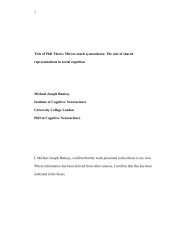Vyacheslav Ivanov and C.M. Bowra: a ... - UCL Discovery
Vyacheslav Ivanov and C.M. Bowra: a ... - UCL Discovery
Vyacheslav Ivanov and C.M. Bowra: a ... - UCL Discovery
Create successful ePaper yourself
Turn your PDF publications into a flip-book with our unique Google optimized e-Paper software.
covering several pages; 16 distichs also figure prominently throughout his later collections. As a<br />
form generally associated with the development of a complete thought, the distich was well<br />
suited to <strong>Ivanov</strong>'s fondness for the epigrammatic style in poetry. 17 He would often choose<br />
distichs for the expression of a particularly powerful experience, encapsulating a moment of<br />
religious revelation or prophetic insight. For example, the epigraph to Cor Ardens, dedicated to<br />
the memory of Lidiya Zinov'eva-Annibal, takes the form of a distich in Russian. 18 In the same<br />
year as he composed his distichs to <strong>Bowra</strong>, he published an extract from his letter of 1939 to<br />
Karl Muth entitled ‘Ein Echo’, describing a mystic experience that had occurred some thirty<br />
years earlier <strong>and</strong> his attempt to capture this private revelation in the ‘golden ring’ of a Latin<br />
distich. 19<br />
In the case of his address to <strong>Bowra</strong>, <strong>Ivanov</strong>'s choice of the distich served several<br />
purposes. It underlined their affinity as fellow classicists <strong>and</strong> set their relationship within the<br />
framework of a well developed literary tradition rooted in classical antiquity. The choice of<br />
Latin rather than Greek emphasised the importance of Latin as the mediating culture through<br />
which the legacy of Greek antiquity passed into the European tradition of humanism; it was the<br />
language in which humanists such as Erasmus wrote when corresponding with their peers.<br />
Furthermore, because of its inherent duality of form (based on the couplet), the distich was<br />
uniquely suited to the theme of <strong>Ivanov</strong>'s address, which deals with several sets of dualities: the<br />
relationship between two people (<strong>Ivanov</strong> <strong>and</strong> <strong>Bowra</strong>, author <strong>and</strong> addressee), the dialogue<br />
between two cultures (native <strong>and</strong> foreign), the presence of two forms in the act of poetic<br />
16 <strong>Ivanov</strong>, Sobranie sochinenii, I, 635-42. In the opening distich from this cycle, ‘Veste detracta’ (the Latin title is<br />
followed by a distich in Russian), <strong>Ivanov</strong> announced his preference for the ‘naked’ distich, not clothed in rhyme (the<br />
true classical form of the distich).<br />
17 See S.S. Averintsev, ‘Gnomicheskoe nachalo v poetike Vyach. <strong>Ivanov</strong>a’, Studia Slavica, 41, 1996, 3-12 (on<br />
<strong>Ivanov</strong>'s use of distichs, 5).<br />
18 <strong>Ivanov</strong>, Sobranie sochinenii, II, 225.<br />
65
















